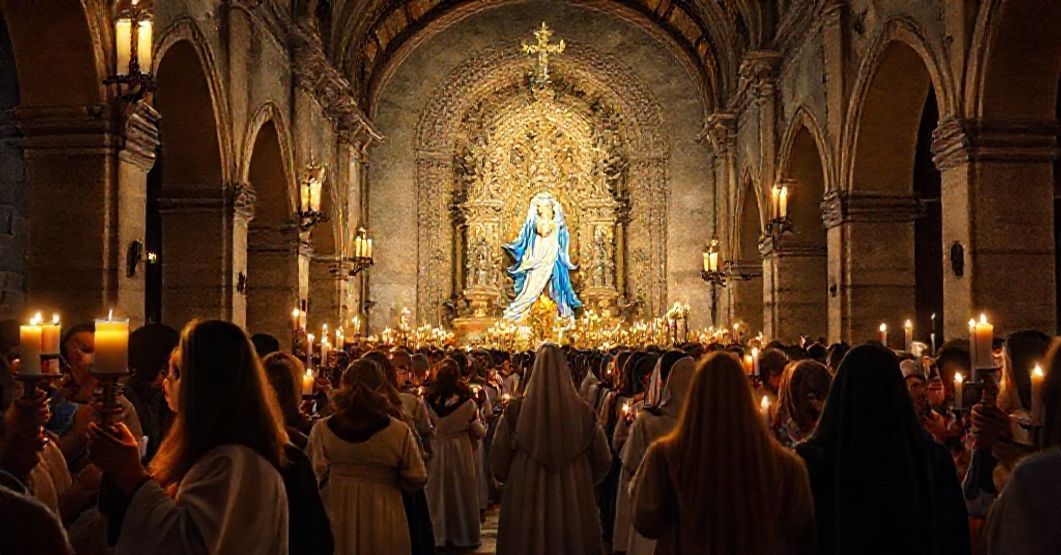Antipopes of the Antichurch



















Timeline of this heretical pontiff
Encyclical Letters
+ 15 posts1959
+ 7 posts1961
+ 4 posts1962
+ 2 posts1963
+ 2 postsApostolic Exhortations
+ 3 postsApostolic Constitutions
+ 93 posts1958
+ 6 posts1959
+ 87 postsMotu Proprio
+ 15 posts1958
+ 1 posts1959
+ 1 posts1962
+ 11 postsApostolic Letters
+ 151 posts1958
+ 4 posts1959
+ 63 posts1960
+ 78 posts1961
+ 1 posts1962
+ 4 posts1963
+ 1 postsSpeeches
+ 99 posts1958
+ 2 posts1959
+ 26 posts1960
+ 29 posts1961
+ 16 posts1962
+ 24 postsMessages
+ 6 posts1959
+ 4 postsHomilies
+ 4 postsLetters
+ 152 posts1958
+ 1 posts1959
+ 48 posts1960
+ 32 posts1961
+ 31 posts1962
+ 30 posts1963
+ 10 postsNot categorized
+ 1 posts1958
+ 1 postsNews feed


Studium et cultus (1959.11.27)
The text is a Latin “apostolic letter” of John XXIII dated 27 November 1959, in which he “confirms and constitutes” the Marian devotion to “Beata Maria Virgo de la Cabeza” as principal heavenly patroness, together with St Euphrasius, for the entire diocese of Jaén, ratifying liturgical honors and privileges and invoking the usual formulae of juridical perpetuity. It presents as pious recognition of an allegedly ancient cult and its miraculous favors, crowned by a canonical coronation and patronal proclamation, yet it is in fact a paradigmatic expression of the pseudo-pontifical cult machinery of the conciliar revolution, instrumentalizing Marian devotion to legitimize an authority and a “church” already drifting from the integral Catholic faith.


Luctifera bella (1959.11.25)
Luctifera bella is a Latin apostolic letter of John XXIII (25 November 1959), in which he laments the devastation of modern wars, praises the Italian National Association of Civilian Victims of War, and declares the Blessed Virgin Mary under the title “Queen of Peace” as its heavenly patroness, granting the usual liturgical privileges attached to such patronage. The entire text, while externally pious, subtly reduces the supernatural mission of the Church to the endorsement of a humanitarian association and to the promotion of a naturalistic concept of “peace” detached from the integral social reign of Christ the King and from the necessity of conversion to the true Faith.


Mirabili nexu (1959.11.13)
The Latin text known as “Mirabili nexu” is an act of John XXIII by which he confers the title of Minor Basilica on the cathedral church of Ferrara, exalting its artistic beauty, historical memories, and its connection with past popes, saints, and ecclesiastical events, and then juridically attaching to it the prerogatives accorded to basilicas within the conciliar/post-conciliar understanding of cult, prestige, and privileges. Beneath the apparently innocuous praise of sacred art, this brief document is a precise manifestation of the new, usurping regime that instrumentalizes Catholic symbols and history to legitimize its authority and to mask the deeper revolution that would soon subvert doctrine, liturgy, and ecclesiology.


Caelesti coruscans (1959.10.30)
The Latin text under the title “Caelesti coruscans,” issued in 1959 under the name of John XXIII, solemnly “confirms” the Immaculate Virgin Mary as principal heavenly patroness and St John Mary Vianney as secondary patron of the Diocese of Lafayette, invoking universal Marian devotion, extolling the Curé of Ars as model of priests, and wrapping this act in the usual juridical formulas of validity, perpetuity, and nullity of contrary acts.
Varia
Announcement:
– News feed –implemented
– Antipopes separate web sites with their all documents refutation – in progress
